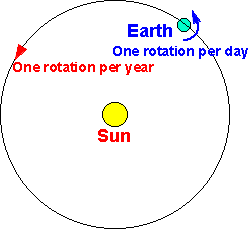
The earth is rotating on its own axis and also rotating around the sun. Ignore any rotation of the sun about its own axis. If the the angular velocity of the earth, about its own axis, is 1 rotation per day and the earth is rotating about the sun once per year, what is the total rotation of the earth in the frame of reference of the sun?
The answer is that the earth is rotating once per day. At first I thought that the rotation about the sun should be added, but this is not the case. My reasoning is as follows:
As explained here, a solid body has
6 degrees of freedom, in other words its position can be defined by a translation
and an orientation. To do this we need to define a
local coordinate system on the body. For example, in the case of the earth,
we could choose to measure relative to the middle of the earths core, or a place
on the surface, or any other location. Now as the earth is moving, both the
translation and orientation are functions of time.
If we choose to measure the local coordinate system relative to a point on the surface, then the translation will be a complicated function of time, but if we measure the local coordinate system relative to the centre of the earth then the translation will be a less complicated function of time. So in this case it is better, but not necessary, to have a local coordinate system relative to the centre of the earth. As far as I can see the orientation as a function of time is independent of the local reference point, in the case of the earth, one rotation per day.
So the angular velocity of a solid object is just the rate of change of its orientation. The angular velocity of a particle on the object takes into account both the translation and the orientation of the object. So the angular velocity of a solid object and its component particles is different. This is what was confusing me.
However, this situation should not be confused with this example, which looks similar, but where the whole frame-of-reference is rotating, in this case the two angular velocities are added.




